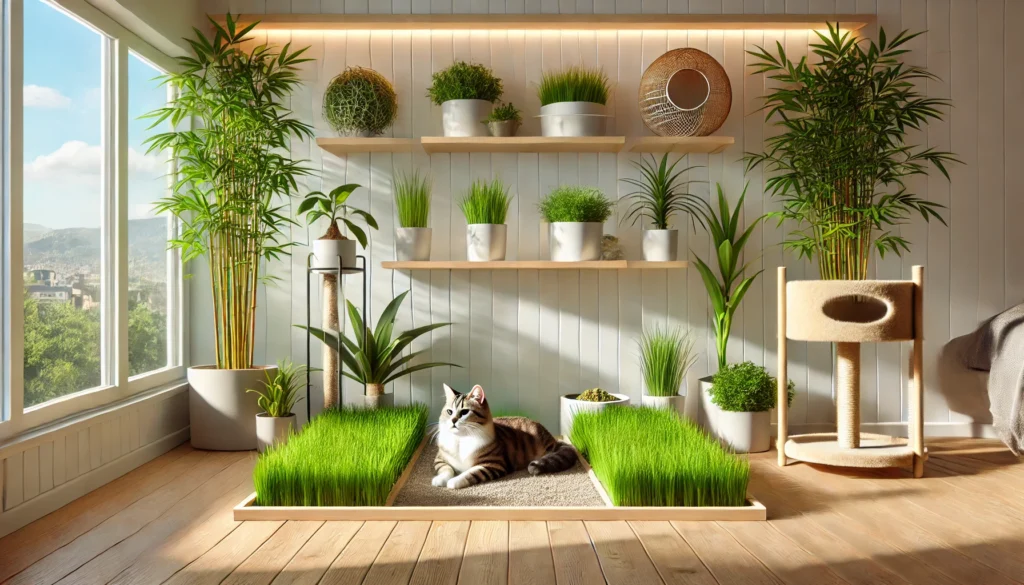Cats are curious, tactile creatures — they love to sniff, chew, and explore plant life. But when you live in an apartment or pet-friendly home, outdoor adventures can be limited. A great solution? Create an indoor cat garden tailored to your feline’s instincts and safety.
With the right setup, you can offer your cat sensory enrichment, safe greens to nibble, and a calming space that mimics nature — all within your living room or kitchen.
Why Make an Indoor Cat Garden?
An indoor garden made specifically for your cat provides:
- Safe chewing alternatives to keep them away from toxic houseplants
- Mental stimulation through new smells, textures, and heights
- Digestive support through safe grasses
- Stress relief and comfort, especially in small apartments
- Natural scratching and rubbing outlets with specific textures
It’s a low-cost way to add enrichment and reduce boredom-related behaviors.
Choose the Right Location
Even in a small home, you can set aside a garden space by:
- Using a sunny windowsill
- Installing a corner shelf with sunlight
- Setting up a plant rack near a sliding glass door
- Creating a mini vertical garden using hanging baskets or stackable containers
Look for indirect light, ventilation, and a location your cat naturally explores — like where they watch birds or sunbathe.
Safe Plants Cats Can Enjoy
Not all plants are pet-safe, so stick to options approved by veterinarians and the ASPCA.
1. Cat Grass
Usually a blend of oat, wheat, barley, or rye
- Aids digestion
- Fun to chew
- Easy to grow from seed indoors
2. Catnip (Nepeta cataria)
A natural stimulant
- Can be eaten or rubbed
- Encourages play and calm after activity
3. Valerian Root (in moderation)
Stimulates some cats (others ignore it)
- Root form preferred over leaves
- Place in cloth sachets or pots
4. Spider Plant
Non-toxic and visually stimulating
- May trigger playful chewing
- Place higher or use hanging baskets
5. Lemongrass
Safe and aromatic
- Can be grown in containers
- Great for sniffing and gentle chewing
6. Bamboo Palm
Lush and safe
- Adds shade and coverage
- Cats love weaving through the fronds
7. Mint (in small doses)
Cool scent that cats often enjoy
- Avoid overexposure as it can upset digestion
Avoid lilies, aloe vera, pothos, philodendron, or jade — all toxic to pets.
How to Set Up Your DIY Garden
1. Choose Pet-Safe Containers
Use unbreakable pots or planters
- Avoid ceramic on high ledges
- Ensure good drainage
- Consider vertical planters for variety
2. Use Organic Soil and Fertilizer
- No pesticides, herbicides, or chemical fertilizer
- Check soil for mold or pests
- Replace every 3–4 months for freshness
3. Group Plants by Use
- Place chewable greens low
- Put scent-driven plants like catnip or mint at eye level
- Use bushy, tall plants as hideouts
4. Add Enrichment Layers
- Place a cardboard box nearby for hiding
- Sprinkle toys or treats around the garden
- Add a scratching post or hanging toy near plants
This makes the space a full sensory corner, not just a planter zone.
Maintenance Tips
Keep the garden healthy and appealing with these habits:
- Rotate plants to prevent overuse or soil fatigue
- Wipe leaves to remove dust and fur
- Trim damaged stems
- Refresh cat grass weekly if nibbled too fast
- Watch for pests or mold and replace any questionable pots
Replace any plants your cat seems to overeat, chew aggressively, or reject after a few tries.
Introduce Slowly
When first showing the garden to your cat:
- Let them approach at their own pace
- Reward with treats or calm praise
- Don’t overreact to chewing — let them explore naturally
- Watch for allergies or upset stomachs with new plants
Each cat is different. Some will nibble gently. Others will nap among the pots. Let their preferences guide your layout.
Bonus: Combine With a Window View
A plant zone paired with a sunny window perch creates a double-enrichment setup:
- Movement (from birds, trees)
- Scents (from garden and outdoors)
- Sun warmth for naps
- Observation territory for confident resting
Consider placing plants on a floating shelf under the window or beside a cat tree.
A Greener World for Indoor Cats
An indoor cat garden doesn’t need to be big or expensive to have a powerful impact. With just a few plants, a sunny corner, and some thoughtful setup, you can bring nature back into your cat’s world — and offer daily enrichment that supports both physical and emotional well-being.
And as a bonus? It makes your home feel more alive, too.






